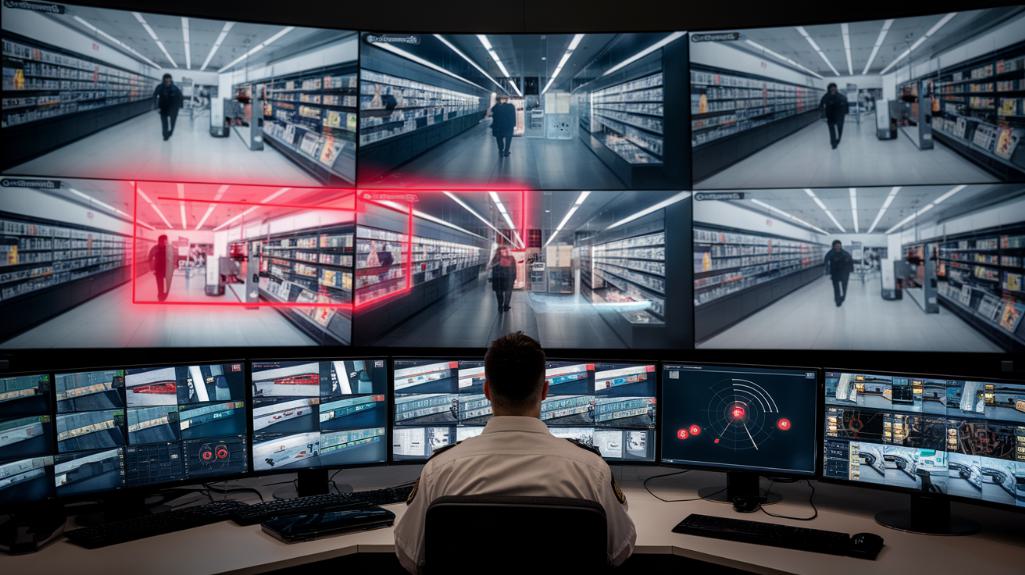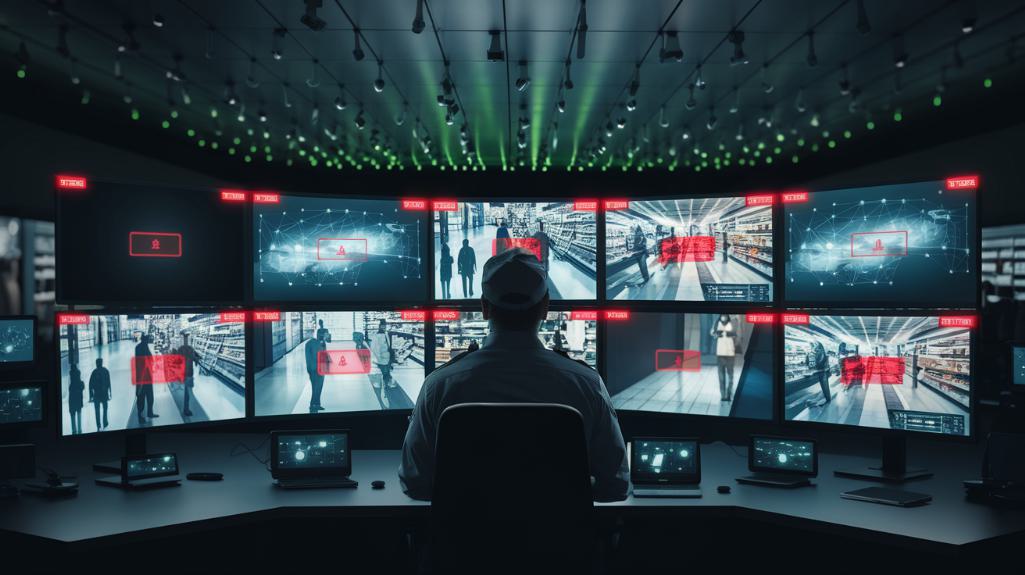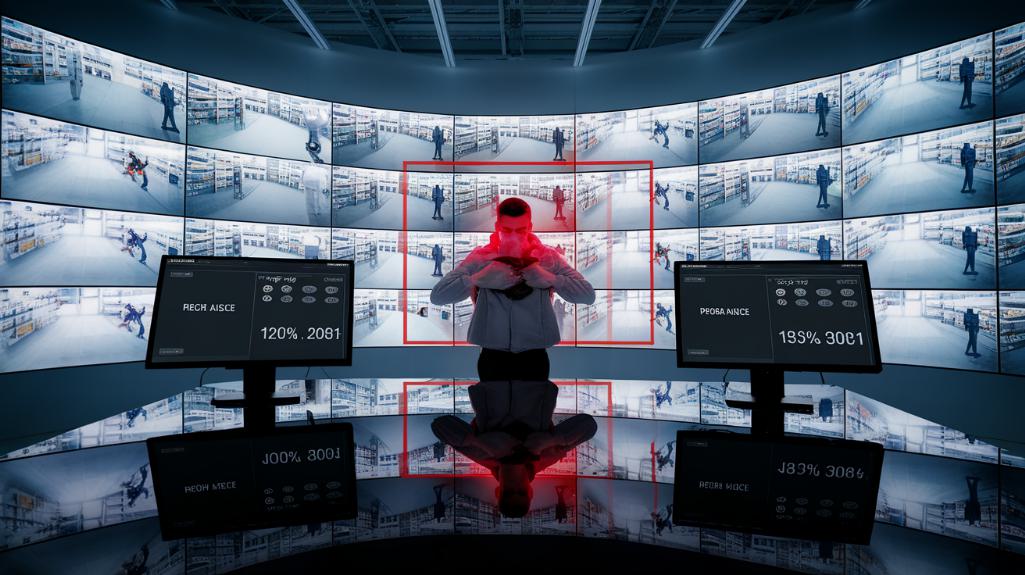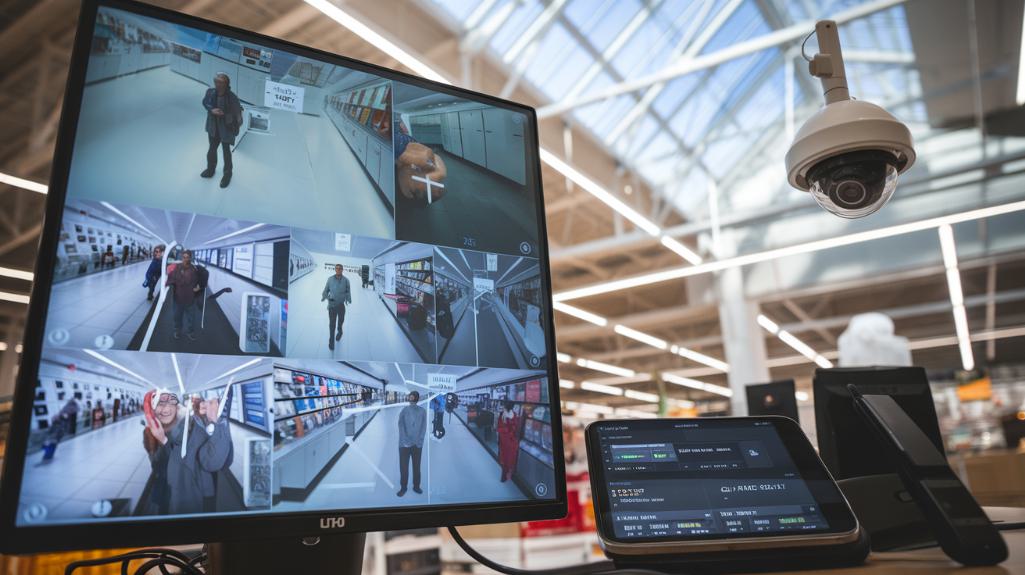AI-powered alert systems help retailers prevent theft through real-time monitoring of surveillance feeds and transaction data. These systems achieve 90% accuracy in detecting suspicious behavior patterns, loitering, and potential fraud. Integration with existing CCTV and POS infrastructure enables immediate response to threats, reducing employee fraud by 30% and accelerating investigations by 50%. Advanced algorithms continuously analyze patterns and adapt to new theft techniques, offering retailers increasingly sophisticated protection against evolving security challenges.
Key Takeaways
- AI systems analyze surveillance camera feeds in real-time, detecting suspicious behavior patterns with 90% accuracy for immediate staff intervention.
- Integration with POS systems enables instant monitoring of transactions, flagging unusual patterns like multiple voids or refunds.
- Facial recognition technology identifies known offenders through watchlist databases, triggering immediate alerts to store security.
- Object detection tracks merchandise movement, comparing scanned items against actual handling to identify potential theft attempts.
- Real-time loitering detection monitors prolonged stationary behavior in designated areas, enabling swift response to suspicious activities.
Understanding AI Alert Systems in Modern Retail Security

While traditional retail security measures have relied primarily on human surveillance, AI-powered alert systems represent a transformative advancement in loss prevention technology. These sophisticated systems leverage real-time data from surveillance cameras to detect suspicious behavior through advanced analytics, enabling immediate response from alert security personnel.
The integration of facial recognition and object detection capabilities allows retailers to monitor inventory movements with unprecedented accuracy. AI-powered security systems analyze customer and employee actions, identifying potential theft indicators before incidents occur.
These loss prevention strategies utilize machine learning algorithms to recognize patterns and anomalies, achieving up to 90% accuracy in threat detection. By processing multiple data streams simultaneously, the technology provides extensive coverage that surpasses traditional surveillance methods, marking a significant evolution in retail security protocols. Additionally, the implementation of AI-driven learning ensures that the system continuously adapts to new theft techniques, further enhancing its effectiveness.
Key Components of Real-Time Theft Prevention Technology
Modern retail theft prevention relies on five interconnected technological components that form the backbone of real-time security systems. AI-powered alerts utilize real-time monitoring to detect unusual behaviors, while object detection algorithms track specific items and individuals. Surveillance systems equipped with anomaly detection analyze customer patterns to identify potential theft-related activities.
| Component | Function | Security Benefit |
|---|---|---|
| AI Alerts | Behavior Analysis | Immediate Response |
| Object Detection | Item Tracking | Theft Prevention |
| POS Integration | Transaction Monitoring | Fraud Detection |
The integration of facial recognition technology with watchlist databases enhances identification of known offenders, while POS system connectivity enables real-time monitoring of transactions for suspicious activities. These components work in concert to create a thorough retail security infrastructure that proactively prevents theft through automated detection and rapid response capabilities. Additionally, Crime Predictor provides comprehensive security by identifying common fraud schemes, enhancing the overall effectiveness of theft prevention strategies.
Behavioral Pattern Analysis and Threat Detection
Modern AI surveillance systems excel at identifying high-risk movement patterns through advanced behavioral analysis, detecting suspicious activities like prolonged loitering with up to 90% accuracy.
The technology monitors multiple camera feeds simultaneously to track erratic movements and unusual shopping patterns that deviate from normal customer behavior.
Integration with POS systems enables real-time analysis of transaction data, allowing AI algorithms to flag discrepancies between scanned items and actual merchandise movement, creating a thorough theft prevention framework.
Identifying High-Risk Movement Patterns
Through advanced behavioral pattern analysis, AI-powered retail security systems can now identify potential theft risks with unprecedented accuracy. Achieving up to 90% accuracy in detecting suspicious behavior, these systems utilize anomaly detection algorithms to differentiate between normal customer activities and high-risk movements.
Real-time alerts enable security personnel to respond promptly when potential threats emerge, greatly enhancing store security effectiveness.
- AI-powered loss prevention systems continuously analyze movement patterns, focusing on indicators like loitering and erratic behavior.
- Advanced algorithms learn from historical data to adapt to evolving theft tactics and improve detection accuracy.
- Real-time monitoring and alert generation allow for immediate intervention before theft occurs.
The integration of these sophisticated detection methods has transformed retail security, creating a proactive approach to prevent theft through early identification of suspicious patterns.
Real-Time Loitering Detection
While traditional retail security methods rely heavily on human observation, AI-powered loitering detection systems now provide a sophisticated layer of automated surveillance that markedly enhances threat prevention capabilities.
These systems achieve up to 90% accuracy in identifying suspicious activities through continuous behavior analysis of customer movements and patterns.
The AI technology monitors designated areas for individuals who remain stationary longer than typical shopping patterns would suggest, distinguishing between normal customer behavior and potential security risks.
When suspicious loitering is detected, the system generates real-time alerts to security personnel, enabling immediate intervention.
This proactive approach has proven highly effective for retailers, resulting in significant reductions in inventory loss prevention.
The integration of AI-powered alerts with existing security protocols creates a robust framework for detecting and preventing theft before it occurs.
Suspicious Transaction Analysis
Building upon loitering detection capabilities, AI-powered systems now extend their reach to transaction-level monitoring, where behavioral pattern analysis serves as a powerful deterrent against retail theft.
These systems analyze real-time data from point-of-sale systems, identifying suspicious transactions through advanced anomaly detection algorithms. By monitoring behavioral patterns, retailers can quickly flag and investigate potential fraud before it escalates.
- AI-powered alerts automatically detect multiple voids or refunds within short timeframes, triggering immediate investigation protocols.
- Anomaly detection algorithms identify transactions that deviate from typical customer behavior, enhancing retail security measures.
- Real-time monitoring of transaction data enables quick response to suspicious activities, greatly improving operational efficiency.
This technology-driven approach to theft prevention has demonstrated measurable success, with retailers reporting substantial reductions in theft incidents through automated fraud detection and systematic behavioral analysis.
Integration With Existing Security Infrastructure

Modern retail establishments can seamlessly integrate AI-powered alert systems with their existing security infrastructure through standardized hardware connection protocols and automated setup procedures.
The implementation of robust network security protocols guarantees encrypted data transmission between AI systems, surveillance cameras, and point-of-sale terminals while maintaining operational integrity.
Real-time synchronization enables immediate alert distribution across multiple security channels, allowing for swift response coordination between AI analytics, human security personnel, and store management systems.
Seamless Hardware Connection Setup
The integration of AI-powered alert systems with existing retail security infrastructure presents a cost-effective approach to loss prevention without requiring extensive hardware replacements.
Retailers can leverage their current network configurations and POS systems to implement AI surveillance cameras and analytical software, enabling real-time data analysis and enhanced theft detection capabilities. This seamless integration maintains operational continuity while greatly improving security measures and reducing inventory shrinkage.
- AI surveillance cameras connect directly to existing CCTV networks, providing immediate enhancement of monitoring capabilities.
- Integration with existing POS systems creates a unified platform for transaction monitoring and video correlation.
- Current power and network configurations support AI technology deployment without additional infrastructure modifications.
The streamlined setup process guarantees minimal disruption to daily operations while maximizing the effectiveness of new AI-powered security features through coordinated system communication and automated alert generation.
Network Security Protocol Implementation
While deploying AI-powered surveillance systems, implementing robust network security protocols becomes paramount for safeguarding sensitive theft detection data and guaranteeing system integrity.
These protocols establish secure communication channels between AI systems and existing security infrastructure, enabling reliable transmission of real-time alerts and operational oversight information.
Implementation involves multiple layers of protection, including advanced encryption methods for data transmission and strict access controls to prevent unauthorized access.
The integration seamlessly connects AI-powered surveillance with traditional monitoring tools, creating a unified security framework.
Regular updates to these protocols help systems adapt to evolving threats, maintaining the effectiveness of theft detection mechanisms.
This thorough approach guarantees that retailers can confidently rely on their AI-powered alert systems while protecting sensitive operational data from potential security breaches.
Real-Time Alert System Sync
Integrating AI-powered alert systems with existing security infrastructure enables retailers to considerably enhance their theft prevention capabilities through seamless data synchronization and unified monitoring.
These systems analyze real-time monitoring feeds from CCTV networks and point-of-sale systems simultaneously, detecting suspicious behaviors and transaction anomalies. Customized alerts notify security personnel instantly, facilitating rapid response to potential theft incidents across retail environments.
- Advanced algorithms process multiple data streams to identify theft patterns and trigger immediate notifications
- Cost-effective upgrade path leverages existing security equipment while adding AI-powered detection capabilities
- Customizable alert parameters reduce false positives and focus on specific security challenges unique to each store
The synchronized approach guarantees thorough coverage while maintaining operational efficiency, making it an essential tool for modern retail loss prevention strategies.
Impact of AI Alerts on Loss Prevention Metrics
Modern AI-powered alert systems have revolutionized retail loss prevention, delivering measurable improvements across key performance metrics. With a 90% accuracy rate in detecting potential theft through real-time monitoring of suspicious behaviors, these systems greatly enhance security teams' ability to prevent losses before they occur.
The impact on loss prevention metrics is considerable, as retailers report a 30% reduction in employee fraud through the integration of transaction data with video evidence. AI-powered alerts accelerate fraud investigations by 50%, enabling swift response to flagged incidents.
This efficiency helps address the $13 billion annual cost of retail theft in the U.S. Additionally, these systems strengthen compliance inspections by maintaining extensive audit trails of suspicious transactions, protecting retailers' valuable licenses for regulated products like liquor and tobacco.
Training Staff to Respond to AI-Generated Alerts
Building upon the technological capabilities of AI alert systems, effective staff training emerges as a key factor in maximizing theft prevention outcomes. Retail loss prevention strategies greatly improve when employees understand and respond efficiently to AI-generated alerts. Through simulation exercises and thorough training programs, staff learn to identify and address various theft behaviors promptly, reducing response times by up to 50%.
- Implementation of AI-driven security requires structured training protocols focusing on quick intervention and proper alert interpretation.
- Regular feedback loops between staff and management enhance response strategies and refine AI alert effectiveness.
- Ongoing training sessions using real-time scenarios help employees develop consistent behavior patterns when addressing potential theft incidents.
The integration of employee feedback with AI-generated alerts creates a more robust theft prevention framework, enabling retailers to maintain a proactive security stance while optimizing staff performance.
Building a Comprehensive Anti-Theft Strategy With AI Tools

While traditional security measures remain valuable, retailers who leverage AI-powered surveillance systems can construct a more dynamic and responsive anti-theft strategy.
By integrating real-time alerts with existing loss prevention protocols, stores can achieve up to 90% accuracy in theft detection through extensive monitoring of both customer behavior and employee activities.
The strategy combines multiple AI capabilities: anomaly detection monitors unusual inventory movements, security cameras with facial recognition identify known offenders, and point-of-sale integration flags suspicious transactions that may indicate employee fraud.
This multi-layered approach enables retailers to move beyond reactive measures to proactive theft prevention. Real-time alerts empower security personnel to intervene before losses occur, creating a more efficient and effective loss prevention system that addresses both external theft and internal shrinkage simultaneously.
Frequently Asked Questions
How Much Does Implementing an Ai-Powered Retail Security System Typically Cost?
Implementation costs vary considerably based on cost factors like system components, installation expenses, software licensing, and store size, typically ranging from $25,000-$150,000 per retail location plus ongoing fees.
Can AI Alerts Distinguish Between Intentional Theft and Accidental Scanning Errors?
Advanced surveillance systems integrate AI accuracy to differentiate between intentional theft and accidental errors by analyzing customer behavior patterns, enabling effective loss prevention while minimizing false alerts in retail environments.
What Happens to the Surveillance Footage After AI Analysis Is Complete?
Surveillance footage undergoes encrypted storage with defined data retention periods. Legal requirements and privacy policies govern accessibility, while regular auditing guarantees compliance with user consent and analysis transparency protocols.
Are There Privacy Regulations Specific to Ai-Powered Retail Surveillance Systems?
Retail surveillance systems must comply with data protection laws, requiring transparency requirements, consent policies, and regular technology audits. Privacy concerns around biometric data collection mandate strict consumer rights protections and risk assessments.
How Often Do AI Security Systems Require Updates or Maintenance?
AI security systems require monthly software upgrades, weekly performance enhancement, and quarterly hardware checks. Regular security patches, user training, and vendor support guarantee peak functionality through systematic maintenance procedures.
Conclusion
AI-powered alert systems have proven to be transformative tools in retail loss prevention, delivering measurable reductions in shrinkage rates and enhanced security outcomes. Through integrated behavioral analysis, real-time monitoring, and automated threat detection, retailers can now respond proactively to potential theft incidents. When combined with proper staff training and existing security protocols, these systems create a robust, data-driven defense against retail theft.



